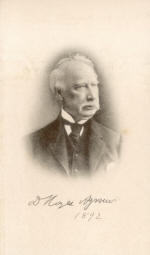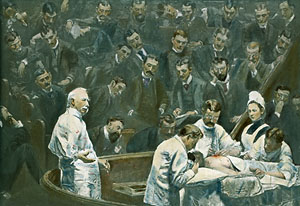Name: David Hayes
Agnew
Death date: Mar 22, 1892
Place of death: Philadelphia, PA
Birth date: 1818
Type of practice: Allopath
Practice specialities:GS General Surgery
States and years of licenses:PA, 1881
Medical school(s): University of Pennsylvania School of
Medicine, Philadelphia, 1838, (G)
Journal of the American Medical Association Citation:
18:468,505 |
 David Hayes Agnew
was born in Nobleville (later Christiana), Lancaster County,
Pennsylvania, on November 24, 1818, the only child of physician
Robert Agnew and his wife Agnes Noble. Because his parents were
devout Presbyterians, young Agnew was enrolled in 1833 at Jefferson
College (which later combined with Washington College to become
Washington and Jefferson College), but the following year, Agnew
left this Presbyterian college in western Pennsylvania to attend the
newly founded Newark College in Delaware, where his cousin, Reverend
John Holmes, was a professor of languages. His liberal arts
education ended when Reverend Holmes left Newark College after just
one year. Agnew then returned home to study medicine with his
father.
David Hayes Agnew
was born in Nobleville (later Christiana), Lancaster County,
Pennsylvania, on November 24, 1818, the only child of physician
Robert Agnew and his wife Agnes Noble. Because his parents were
devout Presbyterians, young Agnew was enrolled in 1833 at Jefferson
College (which later combined with Washington College to become
Washington and Jefferson College), but the following year, Agnew
left this Presbyterian college in western Pennsylvania to attend the
newly founded Newark College in Delaware, where his cousin, Reverend
John Holmes, was a professor of languages. His liberal arts
education ended when Reverend Holmes left Newark College after just
one year. Agnew then returned home to study medicine with his
father.
In the fall of
1836, just before his eighteenth birthday, D. Hayes Agnew entered
the University of Pennsylvania's medical school. After writing his
graduating thesis on "Medical Science and the Responsibility of
Medical Character," he earned his M.D. in 1838.
After graduation,
D. Hayes Agnew returned to Lancaster County to practice medicine
with his father, continuing the practice after his father retired to
Maryland in 1840. The following Agnew married Margaret Creighton
Irwin, the daughter of Samuel Irwin, who owned a large foundry
business. Samuel Irwin died in 1842, prompting Agnew to put aside
his medical practice to join the family business in 1843. After only
three years, the business failed, leaving Agnew free to return to
medicine.
He
practiced briefly in Cochranville in Chester County before returning
to Philadelphia in the spring of 1848. Determined to become a
surgeon, Agnew's goal was to learn anatomy through dissection, often
finding his cadavers on late-night forays for bodies in Potter's
Field, especially during the cholera epidemic. By 1852, he had
developed enough knowledge and skill to purchase the Philadelphia
School of Anatomy, which provided Philadelphia doctors with private
dissecting rooms for their office pupils. In 1854, Agnew went on to
establish the Philadelphia School of Operative Surgery. His ten
years of successful management of these two schools established
Agnew's reputation as an anatomist and as a surgeon and earned him
appointments as a surgeon at Blockley in 1854, as a lecturer for
Professor Henry Hollinsworth Smith at the University of Pennsylvania
in 1858, and as a demonstrator in anatomy for
Joseph Leidy at the same University in
1863.
By the time of
Smith's retirement in 1871, Agnew was one of the leading surgeons in
America and the logical successor to Smith as Penn's professor of
both clinical and demonstrative surgery. Later, in 1877, Agnew
became the first to hold the newly founded John Rhea Barton
Professorship of Surgery. During his Philadelphia career Agnew
performed surgery not only at University Hospital, but also at
Philadelphia Hospital, Wills Eye Hospital and the Orthopedic
Hospital. During the Civil War Agnew served at two Army hospitals,
as surgeon in charge of Hestonville Hospital and as consultant
surgeon to Mower General Hospital. When Charles Guiteau shot
President James Garfield in 1881, it was Agnew who was called to
Washington to serve as the chief consultant; during the months of
Garfield's illness before his death, Agnew not only gave medical
advice, he also spent many hours at the President's bedside,
offering comfort and conversation.

It was in
honor of Agnew's 1889 resignation as Professor of Surgery, that
Penn's current medical students, led by the graduating members of
the
Medical Class of 1889, commissioned Thomas
Eakins to paint the "Agnew Clinic." Completed by Eakins in just
three months, this impressive painting was unveiled at the
commencement ceremonies that year. Agnew died less than three years
later, in March of 1892.
Penn Biographies